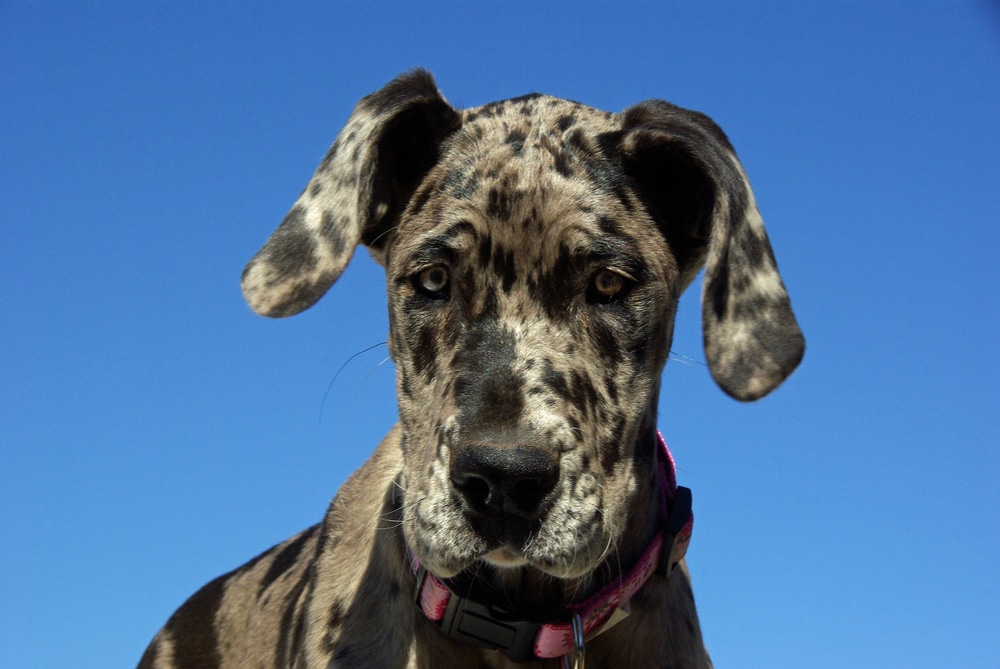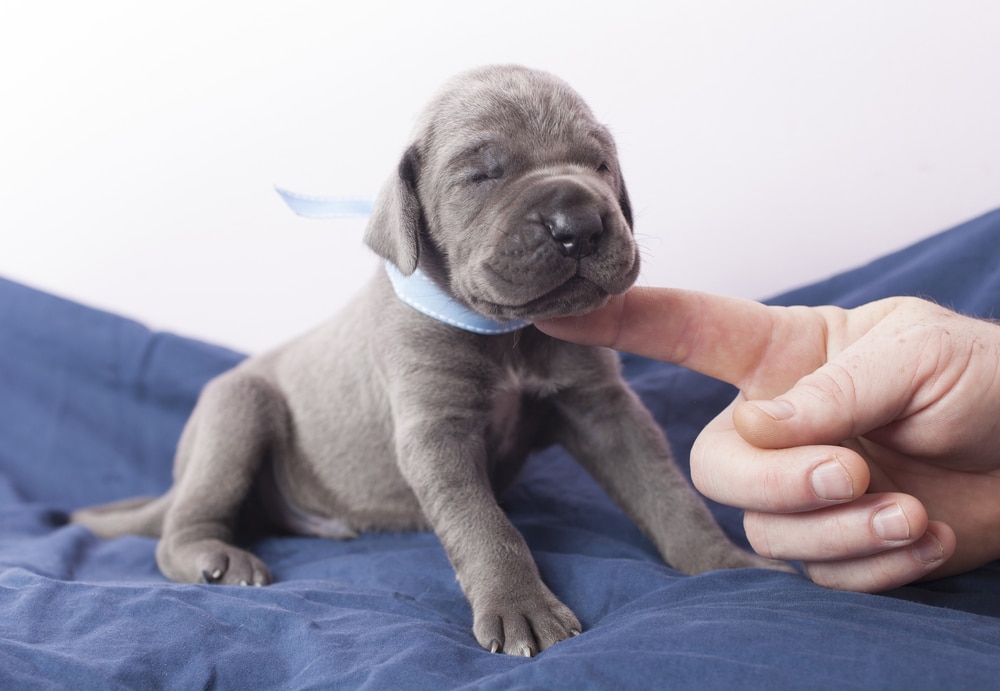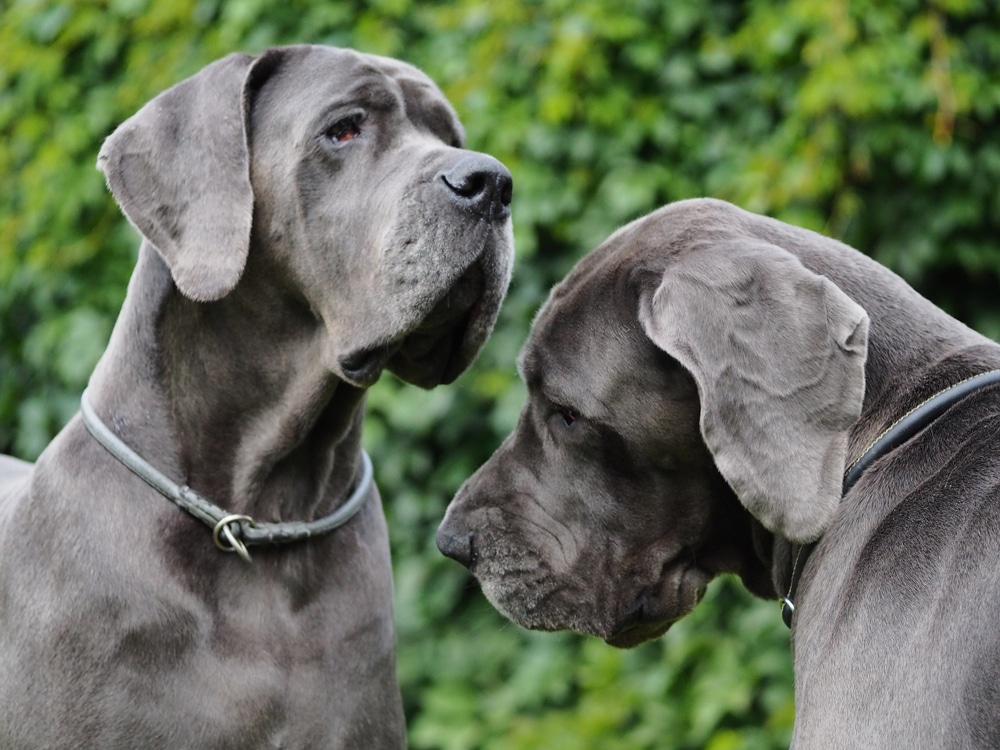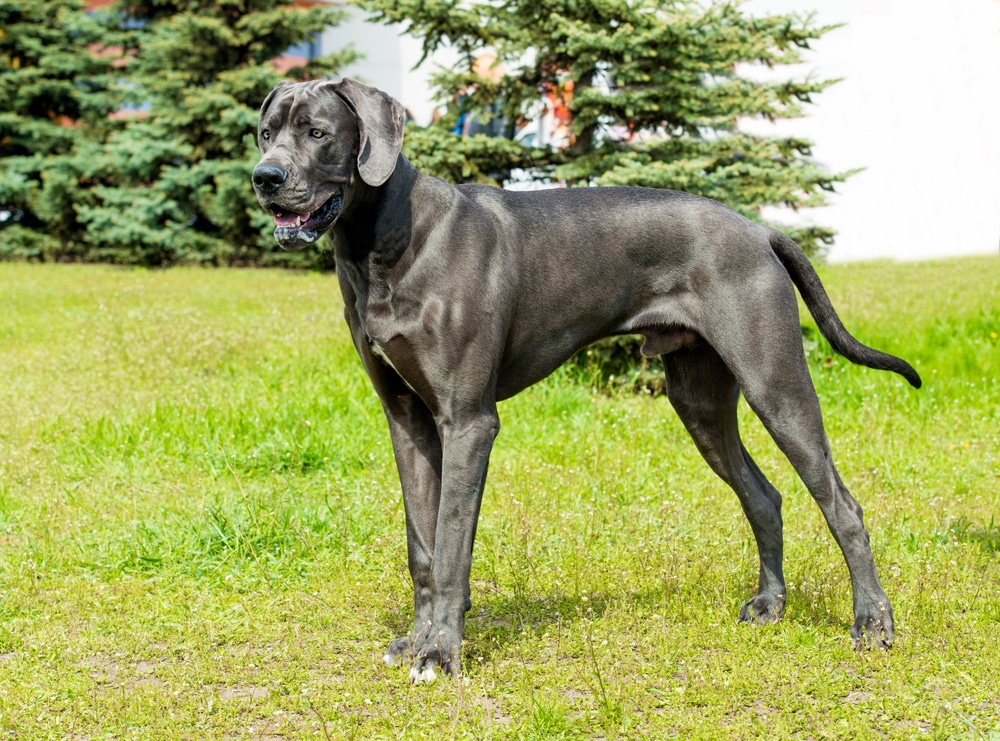“This post contains affiliate links, and I will be compensated if you make a purchase after clicking on my links.”
Last Updated on March 19, 2023
A Blue Great Dane is one of the seven official coat colors of the Great Dane breed. And among all these, Great Danes with the blue coat are probably the most sought after due to their eye catching and mesmerizing coat color.
Get to know this show-stopping Great Dane coat color in this article and continue reading below!
Blue Great Dane Appearance

Blue Great Danes are a sight to behold. These dogs have a pure steel blue coat that shines so beautifully under the sun. While not entirely rare, it can be challenging to produce them.
These dogs get their coat color as a result of breeding two Great Danes that carry a recessive blue gene. This gene doesn’t cause any color on the dogs’ coat, rather, it “dilutes” or lightens the coat color of these dogs. And the gene only works its magic on the black pigment. Hence, the reason why Blue Danes are sometimes referred to as a tainted variant of a Black Great Dane.
Furthermore, Blue Danes have blue noses, which is an easy way to indicate if a Great Dane has a blue coat or not.
Eye color
Blue Great Danes are born with blue eyes. But most of the time, their eye color doesn’t stay the same. As they grow older, their eyes become a shade of brown – typically amber, dark brown or light brown.
However, it is not rare to have Blue Danes that are born from a Harlequin parent to retain their blue eyes until they grow old and mature.
AKC Breed Standards
According to the American Kennel Club or AKC’s breed standards, a Blue Great Dane should follow these standards:
- The color shall be a pure steel blue.
- White markings on the chest or toes are not desirable.
Like the Black Great Danes, Blue Danes only have two standards to follow. However, these are not easily met.
As per breed standards, a Blue Dane’s coat color should be pure steel blue. There are other color variations, but since pure steel blue is what the breed standards indicate, Danes with this shade of blue are the most sought after.
Furthermore, like the Black Dane, a Blue Great Dane that has white markings on its chest and toes is not desirable and is deemed to be ineligible for dog shows.
Blue Color Variations
Interestingly, Blue Danes come in different shades of blue. While they are not all recognized by AKC and not as popular, they’re still as beautiful as the pure steel blue Danes and make great family companions.

The other variations of Blue Great Danes are the following:
1. Blue Merle Great Dane
Blue Merle Great Danes have a brownish blue or dark blue base coat color with blue or dark blue spots. The spots may appear black due to their already dark base coat.
What separates Blue Merles from other Blue Great Dane variations is that they are not a result of the recessive blue gene that causes the color of their coat. The blue in a Blue Merle’s coat is a product of the Merle gene.
The Merle gene, which is a dominant and dilution gene, partially lightens the Blue Danes’ coat color, which is why you can still see spots in their coat that creates a Merle pattern.
2. Blue Harlequin Great Dane
Blue Harlequin Great Danes are Harlequins that have a white base coat with blue patches all over their body. The recessive blue gene will dilute the black pigment in their coat to a greyish blue coat.
Blue Harlequins are a result of breeding a Harlequin and a Blue Dane. And while they’re considered a mismark of the breed, they’re actually quite unique, expensive and real eye catchers.
3. Blue Fawn Great Dane
Blue Fawn Great Danes look just like your typical Fawn Dane. They have a fawn base coat color but have a blue mask instead of black. And the shade of blue they have is more of a charcoal blue. Furthermore, since they’re a variation of the Blue Dane, they’ll most likely have a blue nose as well.
4. Blue Brindle Great Dane
Blue Brindle Great Danes have a fawn base coat like regular Brindles. But instead of black stripes, they have blue stripes.
Lifespan
The Blue Dane’s lifespan is the same as the other Great Dane colors.A Great Dane’s lifespan is known to be shorter than other breeds. And on average, they can live between 6 to 10 years.
Some Great Danes don’t even make it until 7 years old. But there are a few cases of Great Danes being able to live until they reach 12 years old.
Are Blue Great Danes Rare?
Blue Great Danes are not rare, per se. But they are not as common as the other Great Dane colors like fawn. And like Harlequin Danes, they can be unpredictable and challenging to produce in a litter.
Breeding
To produce Blue Great Dane puppies, you need to breed two Blue Danes together. At times, breeding two Black Great Danes also produce Blue Dane puppies.
However, as mentioned above, breeding Blue Danes can be challenging and unpredictable. At times, even if you breed two perfectly healthy Blue Great Danes, they fail to produce Blue Dane puppies in a litter.
Furthermore, it is important to note that cross breeding a Blue Dane with another Dane color might not produce Blue Dane puppies.
Can You Breed a Blue Great Dane with a Harlequin?
Yes, breeding a Blue Great Dane with a Harlequin is possible. However, if you’re looking to breed for show dogs, then breeding these two will most likely produce mismarks called Blue Harlequins that are not eligible for dog shows.
However, if you’re not after a show dog, and just want a family companion, then breeding these two should not be a problem.
Puppy Growth

The Growth of Blue Great Danes corresponding to Great Dane breed is rapid. And to put their fast growth into perspective, the growth that happens with a Great Dane puppy in a year is equivalent to the growth that can happen to a human child in their first 14 years.
Blue Great Dane Puppy Size
A Blue Great Dane puppy weighs just 2 pounds at birth. They can grow from 8 lbs at 4 weeks to anywhere between 100 to 200 lbs at 15 to 18 months.
Once the dog develops, it can easily surpass most of us when standing on its two feet. These dogs can reach their maximum height by the time they turn 1 or 2 years old.
Although, the height and weight of Blue Great Danes can differ for female and male. Usually, a male Dane is taller and heavier than a female Great Dane. Female Danes can grow up to 30 inches and males can grow up to 32 inches. Furthermore, the weight for female Danes can be anywhere between 99 to 110 lbs. And that of a male Blue Great Dane can be anywhere from 100 to 130 lbs.
The Great Dane’s growth spurt varies from dog to dog, but in general, the rapid growth happens around 4to 6 months of age.
Health Concerns
The health concerns for a Blue Great Dane are the same as any other Dane. Since Great Danes are a large breed, they are predisposed to a number of issues like bloat and hip dysplasia.
But aside from these issues, there are no known problems or complications related to their coat color or due to their recessive blue gene.
Temperament
A Great Dane’s coat color doesn’t affect their overall temperament. So a Blue Dane has the same temperament as other Great Danes.
The Great Dane’s temperament includes being gentle, friendly and loyal. They love and are loyal to their owners, and therefore can be extremely protective of them. With their size and protectiveness, they actually make excellent watchdogs.
They are also obedient and would do anything to appease their owners, which is an advantage when it comes to training.
Furthermore, they can be friendly towards strangers and other dogs. They also adore children children and can play with them (with adult supervision, of course). And since they are friendly dogs, they love hanging out with their owners and are not good with being left alone.
However, these are all widely-accepted generalizations of the breed’s temperament. Every Dane is unique and their temperament will vary depending on how well they are raised and trained.
Diet
Blue Great Danes undergo a rapid growth. And it’s important to sustain this with the food they eat. Knowing how much and what to feed them is vital to their growth and overall health.
Their diet should be high in protein and low in fat. This is usually recommended for large dog breeds like the Great Dane because this is the type of diet that can promote proper bone and muscle growth.
Great Danes should eat dog food that is specifically formulated for large canine breeds. Furthermore, puppies and adult Danes should have different food requirements. So, you have to ensure that your Blue Dane puppy is eating puppy food and your adult Blue Dane is eating adult food.
Furthermore, to ensure that your Dane wouldn’t develop bloat, you have to feed them twice or thrice a day instead of once.
Training
Training Blue Great Danes is no different than training other Great Danes. The owner has to be committed enough to ensure that the training is effective and that their Danes grow up properly trained and well-behaved.
Furthermore, training should start as early as possible. And this is because puppies are easier to train and Great Danes are a breed that needs a lot of socialization starting from a young age.
Exercise
While the Great Dane temperament suggests that Great Danes are not as active, it’s a bit different when they’re puppies. Great Dane puppies are a lot more active and need more exercise than adult Danes.
So, when they’re puppies, more exercise and play time is suggested. But once they become adults, a minimum of 20 and a maximum of 40 minutes walk daily is all you need to ensure they get enough exercise. You can either take them on a walk once or twice everyday.
Since walking is the most suggested form of exercise for these large canines, it’s important to leash train them starting from a young age.
Grooming
Grooming a Blue Great Dane is the same as grooming any Dane. Since they are considered moderate shedders, regular brushing will help with shedding.
Grooming these big beautiful dogs isn’t as difficult or complicated as other dog breeds, since they have a single coat. However, the problem mostly comes from their size, since they are huge, they have a lot of hair to shed.
Furthermore, Great Danes are known to have a short, smooth and shiny coat. To help maintain this, bathing them every 2 or 3 weeks will do. Frequent bathing (we’re talking once a week) is not recommended because this can make their skin dry.
Blue Great Dane Price
A Blue Great Dane can cost anywhere between $800 to $3,000. The price will ultimately depend on the breeder you’re getting it from, your location and the dog’s pedigree.
Some Blue Danes are more expensive, especially if they are show-quality or if they have the harlequin pattern. However, it’s important to note that having a higher the price tag doesn’t equate to a better and healthier dog.
If you want a healthy Blue Great Dane, then you have buy from a reputable breeder. This is because they always ensure that their litters are healthy. Unethical breeders only breed to make a profit, and most of the time they do not really consider the health and welfare of the puppies.
Our Suggestion

A Blue Great Dane is a beautiful coat color. And it’s easy to see why they’re so popular. If you really are keen to owning one, it’s always important to make an informed decision after doing enough research on the coat color.
If you are planning to get a Blue Great Dane, make sure to buy one from a reputable breeder, regardless if you’re looking for a pet or a show dog. Again, unethical breeders only breed for profit and there is no assurance that the puppies they sell are healthy or fit.

not afraid of the road, only afraid of short.
Is it safe to breed a blue Great Dane and a fawn? What colour puppies are they likely to produce . many thanks
Liz
Blue and Fawn Great Danes can be bred. There are no potential risks in the breeding provided the dogs are healthy. This breeding process produces all Black Great Dane puppies which are carriers of Blue color pigment and Fawn color pattern.
Could you breed a Blue great dane with a Merle great dane?
Although Merle GD are acceptable yet the caution involved in the breeding process still applicable. As the merle gene holds A HUGE potential of producing marred GD puppies it is not advised usually to breed Merle GDs.
Can you breed a blue harlequin (white coat with blue patches) with a black? What colors would this produce?
I have a Great Dane she is 4 years old she is all black except for her chest and socks on her feet. Her dad was a Blue Harqulin and mom was a Harqulin so my question is she considered Harqulin or something else and I am wanting to breed her we are planning to breed her with a Mantle is that ok